(Fixed double redirect) |
(Added category) |
||
| Regel 242: | Regel 242: | ||
[[Category:Style Guides]] | [[Category:Style Guides]] | ||
[[Category:Table examples]] | |||
Versie van 3 jun 2014 16:15
The following article contains key information on properly creating junctions and the roadways between them. Be sure to review it in its entirety before editing the map.
Simple is better
When representing junctions, intersections, interchanges, cross roads, corners, etc., the Waze map does not need to perfectly match the road layouts it represents. The primary goal is to represent the real world as simply as possible in the maps and only introduce complexity in the maps to address complex issues.
The basics
This guide requires a complete understanding of editing the maps with Waze Map Editor (WME).
Map editing 101
Although it is highly recommended to read the Editing Manual before touching the map, it is required that you do not continue with this guide until you have read the following:
Junction definition

|

|

|
The Glossary on Junctions provides details on how junctions can appear differently in the editor depending on its state or condition.
A junction is made up of three things:
- Two or more road segments
- One point where all the segments meet (the junction point itself)
- Turns allowed or restricted when traveling from one segment to another through that junction point
Controlling Turn Instructions
| Keep Right | Keep Left |
| Turn Right | Turn Left |
| Exit Right | Exit Left |
Turn instructions are critical for proper client navigation. They are controlled by:
- The angle set between segments at junctions.
- The road names.
- The road types.
Review the article controlling turn instructions for a complete understanding of the requirements and issues surrounding this topic.
Surface Streets
Intersections

|

|

|
 | ||
The most basic junctions form three-way and four-way intersections. Some variations resemble bow ties.
In all cases it is important to configure these intersections properly. Detailed information is covered in the Intersections article.
No Outlet Roads
Roads which only have one way in and one way out can present challenges to the routing server, although they seem simple to our minds.
Dead Ends
Dead Ends (a.k.a. No Exit, Closed, No Through Road, No Outlet) are road segments that simply end, with no continuation or connections at one end. In some areas, a Dead End may be synonymous with a Cul-de-sac. In the US, a "No Outlet" sign may be used to indicate a road which itself is not a dead end, but it only connects to other dead end roads. It can also be used as a "friendlier" alternative to the typical Dead End sign.
Within the Map Editor it is possible to represent a dead end road with multiple segments if there are private driveways or parking lot roads mapped and connected. In that case, only the very last segment is considered the dead end segment.
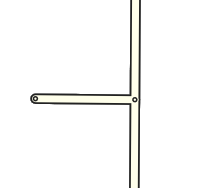
Make sure that there is a junction indicator (the small blue dot, not just a geometry node) at the very end of the segment. While this one segment does not actually constitute a junction, the small blue dot is a visual indicator to the editor that the end of this segment is properly set up. This is necessary to ensure proper routing out of the segment. See the Cul-de-sac section below on when and how to fix this.
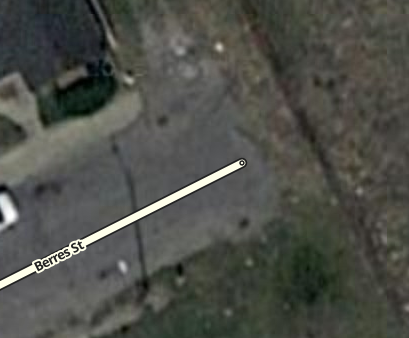
This final junction indicator must be located near the end of the road, but it should be located where there is still pavement as not to negatively impact client routes. Waze only considers the road fully traversed if both ends of the segment are fully crossed. If the junction indicator at the end of the segment happens to be at the edge of the pavement (or off of the road surface if aerials are not exactly aligned), it will be very difficult for a driver to cross that junction. A good rule of thumb is to have the end of the segment the same distance from the end of the pavement as it is from each side of the road.
With such a placement, the driver is given a chance to cross that junction indicator for that segment. Also check for the proper u-turn setting as covered in the best practices article on u-turns.
Cul-de-sacs
See also: Cul-de-sac article on Wikipedia
A Cul-de-sac (a.k.a. Court in the US) is a common treatment of a dead end street in a residential neighborhood.
In almost every situation, a cul-de-sac should be treated exactly as a dead end street, with the final junction indicator in the center of the bulb of the cul-de-sac. Be sure the free end of the final road segment has small blue dot displayed at the tip (when not editing or selecting the segment). If there is no blue dot, please correct it by following the steps for fixing dead ends.
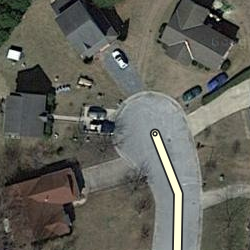
The junction indicator should be located close to the middle of the bulb and NOT near the outer edges. If the end of the segment is positioned along the perimeter of the bulb, there may be difficulty in processing client routes. Waze only considers the road fully traversed if both ends of a segment are crossed. If the end of the segment happens to be on the curb (or off of the road surface if aerials are not exactly aligned), it will be very difficult for a driver to cross end end of the road segment. With the junction in the middle of the visual road, we give a driver a good chance to cross the end of the segment no matter where they drive within the bulb. The exception to this guidance is given in the next example.

|
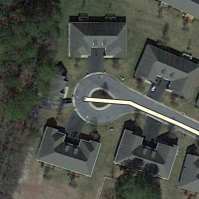
|
This cul-de-sac, with a small island, should be treated as a basic dead end with no loop. The island can be ignored, as there is no significant routing question for the driver once they get to the cul-de-sac.
As for placement of the final junction indicator, here we may get better results by moving the junction out from the true center and over to the outer perimeter of the central island. The shift ensures that the driver has a good opportunity to cross the end of the segment.
However, if the cul-de-sac has a very large bulb with a large island in the middle, it may better be treated as a Loop. A good rule of thumb is if you were standing at the end of the cul-de-sac, can you tell that it is just a cul-de-sac? Or does it look like two different roads? If you see an island, but are not sure if it is significant, leave the Loop out. If "Missing Road" errors occur on the road, then add a Loop.
Loops
Loops are roads that you can enter, and without reversing course, end up at the same place you started.
Loop rules
- A road segment must not start and end on the same junction node (loop back onto itself)
- Two segments must not share the same two end junctions
- Any loop must be made up of three or more segments
If these rules are not followed, the routing server will have difficulty in providing routes into and out of the loop. Any loop broken into three or more segments by a junction will not have this problem.
If there are no natural interruptions (side-streets or driveways) to the loop and the entire loop is represented by one road segment that connects with itself, you must insert superfluous junction nodes along the loop segment. The specific location does not matter, but most people put it near the half-way point of the segment.

|
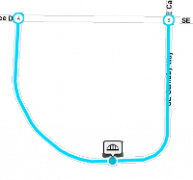
|
Here is an example loop showing the proper three segment configuration. Note that when selecting the two adjacent segments the bridge icon appears tempting an editor to link the two segments. That would be counter productive to the routing server though. The only work around is to either lock the segments at a higher level or find a driveway to add to the map on this road causing the bridge icon not to appear at that point.
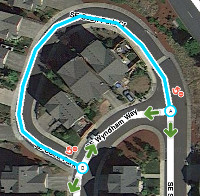
This is an example of an improper 2-segment loop. The routing server will have a difficult time properly routing traffic to or from either of these segments. As indicated above, add a junction point along either segment to create three segments in this loop.

This is a side-by-side example of a proper 3-segment loop and improper 2-segment loop in a parking lot. The 2-segment loop can be fixed by adding a junction node along either segment.
NOTE: It is very easy for an editor to see an extra junction node along a segment, assume it is superfluous, and delete it, when in fact it is necessary and should remain in place! This problem is magnified if the loop road is large or shaped so it is not obvious that it is a loop. One solution is to identify a path or driveway branching from the loop road and add it to the map, forcing a 3-way junction that would be less likely to be deleted.
Loop save errors
The Waze Map Editor may be resistant in editing a loop that does not already follow the rule that it must be broken in two. If you run into saving errors, try one of the following approaches.
If the loop and the road leading to it have the same name:
- Select the loop and the road
- Click the bridge icon that appears (one end of the loop will disconnect from the other)
- Split the loop
- Reconnect the disconnected end of the loop
- Confirm turns
If the loop and the road leading to it have different names:
- Draw a new road segment that connect to the loop/road junction
- Give that new road the same exact name as the loop
- Select the loop and the new road segment
- Click the bridge icon that appears (one end of the loop will disconnect from the other)
- Split the loop
- Reconnect the disconnected end of the loop
- Confirm turns
Here is a video on YouTube showing the second method.
Roundabouts and Traffic Circles
Please see the Roundabouts/USA page for a full discussion of this special type of junction.
At-grade connectors
With exceptions, don't set these segments as ramps! Watch out for all of the turns you need to restrict. For a full discussion, see at-grade connectors.
Interchanges and ramps
An interchange is a road junction where two roads are connected by dedicated roadways, called ramps. The roads connected by an interchange do not intersect one another directly, and if they cross, the crossing is grade-separated.
When to use ramps
Use of the Sjabloon:Ramp type is governed by the following rules:
Ramp and interchange style
For guidance on the proper configuration of ramps, interchanges and wayfinders, see Junction Style Guide/Interchanges.
Special Cases
Transitions

|

|
A transition is a non-junction depicted using a junction node.
Valid examples of where to use a Transition node include:
- Road name changes
- City Limits
- Road Direction changes
- Part of a Loop Road
Before the current house numbering system came into use, transition nodes were used to aid in house numbering, but that is no longer required.
There may be existing transition nodes on the map for other reasons like remaining after a connecting road is deleted, inherited from to the original base map import when rivers and streams created junctions, etc.
As long as you are certain it is not a valid transition node, a superfluous junction node may be deleted. Doing so will simplify the map, eliminate turn restrictions to maintain, and reduce computing resource needs. Also consider removing the geometry node which will replace the junction node you delete, if that geometry node is not needed.
Roads to Nowhere
In certain situations it may be necessary to add road segments that are un-drivable in order to provide accurate navigation instructions.
Actual
A valid use of this technique is at the temporary end of a freeway. As a freeway is built, it is often opened in sections, up to a certain exit. If we map this as a regular freeway segment leading to a ramp segment, no announcement will be made for that final exit, no matter what we name the exit ramp.
This can be confusing if the ramp is set up as a properly signed and numbered exit, especially if a driver is traveling a long distance on this freeway. Imagine traveling down a freeway and seeing your next instruction is "turn left at Main St." You would probably wonder if there was a map error since you shouldn't be making left turns off of a freeways.
If we map even just a little of the future path of the freeway, this gives the routing engine a junction which will generate an "exit" instruction at the end of the freeway, thus eliminating any confusion.
Conversely, if we do NOT want an exit instruction at the end of a freeway, ensure there are no road segments extending past the final exit, to ensure the final exit is the only path out of the final freeway segment.
Fake
(coming soon)
Offset Roads
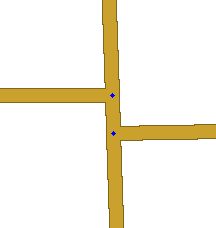
Sometimes you will find two roads which cross, where one does not quite line up with the other.
There are a few things we need to look at in this situation.
- Do the roads actually line up in reality? If so we need to modify the junction to be a basic 4-way junction.
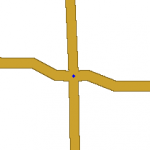
|
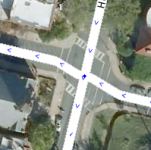
|
- Do the roads ALMOST line up in reality? If you were giving instructions to a person and would tell them to go straight with no mention of any slight turn or jog, then we want to make it into a 4-way junction. You may need to "split the difference" and not follow the centerline of either road to achieve this. The angles are exaggerated in this next example to show how the junction is forced to be close to 90 degrees, then we taper to the true centerlines of the roads. In practice this can be much more gradual and/or done while zoomed in very close.
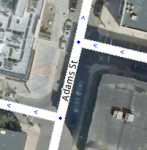
- Finally, is there a true separation between the roads? Would you need to say for example "turn left then make an immediate right"? If so then we will want to leave the junction such that the two sides do not align.
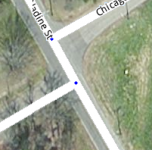
Since we want to avoid very short segments of road (the GPS chips in consumer devices can be very inaccurate which may make it seem that a driver skipped right over a short segment. This will result in automated map errors and possible route recalculations in the client,) it may be wise to shift the side roads as far apart from each other as possible with them still in the proper location (along the far curb lines for a residential street for example). This will maximize the length of the short segment between the side roads.

